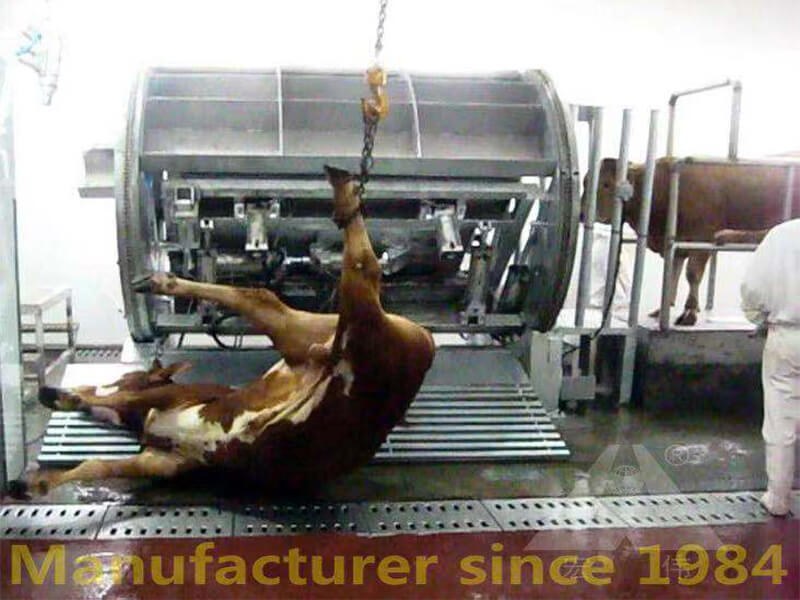
Cattle slaughter is an essential process in the meat industry, ensuring the availability of beef for consumption. In abattoirs, various methods and equipment are employed to perform humane and efficient slaughtering and bloodletting processes. This article provides an overview of the three primary methods used in cattle slaughter and outlines the key processes involved in the bloodletting line. Cattle slaughter box is one of most important abattoir equipments of cattle slaughter line.
Method 1: Living Cattle Slaughtering with Cattle Pneumatic Fixed Halal Killing Box:
In this method, the cow enters a cattle pneumatic fixed killing box, a vital piece of equipment in the cattle slaughter line. The process involves a pneumatic rollover, which secures the cow’s hind leg using a corbel chain. Subsequently, the cow is rolled over for the second time, enabling the entire body to be lifted into the bloodletting rail by a hoist. Once suspended upside down on the rail, the cow undergoes assassination and bloodletting.
Method 2: Cattle Slaughter Knocking Box + Stunning Gun
This method involves the use of a cattle slaughter knocking box in combination with a stunning gun. After entering the flap box of the knocking box, the cow is instantly stunned using the gun. Once stunned, the cow is released and positioned flat on the bullpen for assassination and bleeding. Alternatively, it can be hung on the bloodletting rail for bleeding.
Method 3: Halal Rotary Cattle Killing Box:
The halal rotary cattle killing box represents an advanced approach to cattle slaughter. As the cow enters the flap box of this specialized equipment, its neck is clamped, and its jaw is held up. A knife is used to stab the cow, causing bloodletting. Following the bloodletting process, the hoist lifts the cow’s body into the bloodletting track.
Processes on the Bloodletting Line:
Upon entering the bloodletting line through the bloodletting hoist, several crucial processes are undertaken. These include hanging, bloodletting, electrical stimulation, cutting of the front legs and horns, sealing the anus, and cutting of the hind legs. The bloodletting time is typically designed to last between 5 and 6 minutes to ensure proper bleeding.
Conclusion: Cattle slaughter and bloodletting processes are integral to the meat industry, ensuring the availability of beef products. Understanding the different methods and processes involved allows for the implementation of humane and efficient practices in abattoirs. By employing appropriate equipment and adhering to established protocols, the industry strives to maintain high standards in cattle slaughter while prioritizing animal welfare and food safety.
Note: It is important to consider cultural, ethical, and regulatory guidelines specific to your region when conducting cattle slaughter. This article provides a general overview and should not be considered as comprehensive guidance for specific practices or regulations.
If you want more information, please contact us by email or WhatsApp. You can add our WhatsApp by scanning the QR code on the right.





Haw much is the halal box
Please check your inbox. We have sent an email to you. Thanks